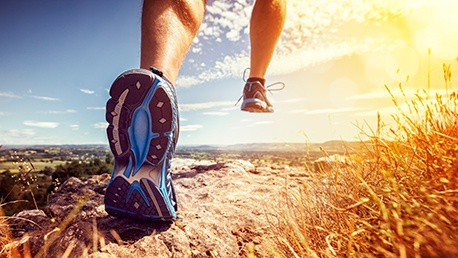
Whether you’re a running newbie or a seasoned marathoner, a well-fitting shoe is a key to success. Proper footwear can improve efficiency and reduce your risk of injury. But with so many options available, where do you begin?
Let’s start with cushioning
Cushion levels run from 1 (least cushion) through 5 (maximum cushioning). More is not always better! A higher level of cushioning can reduce strain on joints, and can be great for new runners or those with larger frames. Shoes with a lower level of cushioning are more flexible and may help build “foot awareness.” Once you have determined what level of cushion you want, it’s time to determine how you run! Pronation is the way your feet roll when walking or running.- Neutral pronation – feet hit the ground with a slight inward roll. Neutral pronators often have normal arches. Your soles will likely wear out evenly from left to right.
- Over-pronation – feet roll inward in an exaggerated way. Many people who over pronate have “flat feet.” The soles of your shoes wear out more quickly on the inside edge.
- Under-pronation (supination) – feet do not roll inward enough, or seem to roll outward. This is common in people with high arches. Under-pronators wear out the outside edges of their soles first.
Cushioned/Neutral Running Shoes
Best for:- High arches
- Neutral or under pronators
- Soft and comfortable
- Lightweight
- Shock dispersion – easier on the joints
- Lacks stability and control, which could mean higher risk of injury
Stability Running Shoes
Best for:- Most runners – these are the most popular kind!
- Moderate pronators
- Enhanced stability and cushioning
- Excellent control and support
- Lightweight
- Not as soft as cushioned shoes
Motion Control Running Shoes
Shoes with stiffer heels Best for:- Over pronators
- Frequent runners
- Maximum control and suppor
- Reduces over pronation
- Good for flat feet
- Durable
- Lack of cushioned comfort
A note on barefoot/minimalist running shoes…
These unique shoes are designed to mimic running with bare feet, which is thought to strengthen your foot muscles. They are tempting, since they feel very “light” on the feet. However, experts disagree on the effectiveness and safety of minimalist shoes. Pros:- Very lightweight
- Increased “feet awareness” – you know how your feet are connecting with the ground!
- Ease of uphill running
- Adjustment takes time
- Minimal support or cushioning
- Higher risk of injury
- Not suitable for beginners